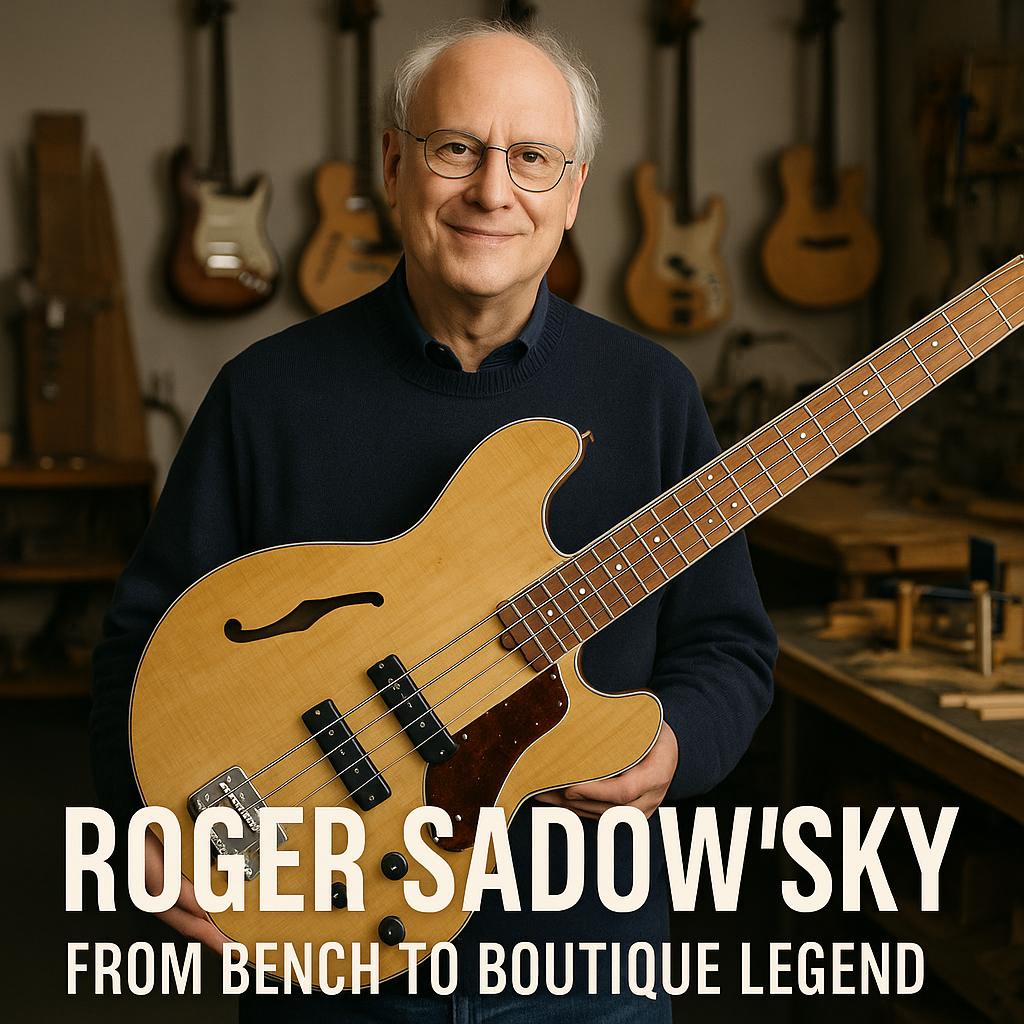Early Life & Background
Roger Sadowsky grew up in New York City in the 1950s. His father listened to big‑band and Sinatra/Nat King Cole‑style music; his mother loved Broadway musicals.
He began playing guitar in the spring of his junior year in college, learning finger‑picking from songs by Gordon Lightfoot and Paul Simon.
Originally, he was pursuing a PhD in psychobiology at Rutgers, but his interest shifted toward guitars and instrument‑making.
In 1972 he began making acoustic guitars in New Jersey under the mentorship of Augie LoPrinzi.
Transition to Repair, Customisation & the “Sadowsky Sound”
By 1974, Sadowsky took over the repair department at a store in Philadelphia (Medley Music) where he spent five years honing his craft, working on restoration, set‑ups, fretboards and electronics.
In 1979 he returned to New York and opened his own workshop — servicing top session guitarists and bassists in Manhattan.
During this period he became known for customising late‑’60s/early‑’70s Fender instruments (for example Jazz Basses) — refretting, re‑truing fingerboards, heavier bridges, shielding, active electronics.
In fact, he coined what is often referred to as the “Sadowsky Sound” through his active tone circuits (initially transistor‑based rather than op‑amp) combined with high‑quality woods and workmanship.
A key insight: as vintage basses surged in value in the early ’80s, Sadowsky recognized that modifying them devalued their “vintage” appeal — so he pivoted to building instruments from scratch that incorporated his mods and improvements.
Founding of Sadowsky Guitars & Instrument Building
The company Sadowsky (also known as Sadowsky Guitars) was formally founded circa 1979 in New York.
He began building electric guitars in 1980, and bass guitars in 1982.
The instruments drew on the Fender Jazz Bass style (for basses) but added his refinements: acoustic‑resonant body chambers, premium materials, quiet electronics, active pre‑amp, optimized neck geometry.
Over time, the range expanded to include archtop guitars, chambered solidbodies (electric guitars), guitars for jazz players (e.g., OM acoustics revival).
Signature Users & Industry Impact
The list of high‑profile musicians using Sadowsky instruments is impressive. Guitars/basses built by Roger have been played by names such as:
-
Guitarists: Jim Hall, John Abercrombie, Pat Metheny, Lee Ritenour, Andy Summers, Chuck Loeb.
-
Bassists: Will Lee, Marcus Miller, Jason Newsted, Verdine White.
These endorsements helped elevate Sadowsky’s reputation from boutique shop to a “go‑to” among top notch studio folks. A quote:
“The objective was to find the best Pre‑CBS bass out there… under $800 then” — and Sadowsky would upgrade it for the working professional.
Business Model, Manufacturing & Philosophy
Sadowsky has maintained a strong ideology of direct player‑interaction, high craftsmanship, and small scale. As he’s said: “I always wanted to deal directly with the player rather than to music stores.”
In 2003, the company began manufacturing in Japan (MetroLine/MetroExpress) to offer lower priced versions while maintaining custom workshop output.
In later years Sadowsky entered into a licensing and distribution agreement (with Warwick GmbH & Co Music Equipment KG) for bass production in Germany — thereby separating the NYC custom shop from higher‑volume manufacturing.
He emphasizes that even with production, the core is about “good wood, good workmanship, good materials … and the best craftsmanship we can possibly put into these instruments.”
Technical & Design Innovations
Here are some of the technical/design aspects that Sadowsky brought to the table (and that your vintage‑oriented audience will appreciate):
-
Active pre‑amp circuits (originally transistor‑based) for basses, giving a strong studio‑friendly signal and minimal “board tweak” requirement.
-
Body design drawing on acoustic guitar‑building experience: chambering, lightweight, resonant bodies even in solid electric instruments.
-
Improved neck construction: e.g., graphite reinforcement strips, optimized headstock thickness, improved stability and sustain.
-
Set‑ups and finish work geared to discerning studio pros: e.g., waterproofing for heavy‑sweat players (as with Jason Newsted’s basses).
Relevance to Vintage Guitar Market & Collector View
From a vintage guitar shop perspective (and given your interest in serial numbers, pot codes, manufacturing changes, historical models), Sadowsky’s work is of special interest because:
-
It bridges the “modded vintage” era (1980s when players were upgrading 60s Fenders) and the boutique custom build era.
-
His earlier modified instruments (e.g., vintage Fender + Sadowsky electronics) can have provenance value themselves—not just original factory spec.
-
His custom shop instruments (especially early 1980s–1990s) have become collectible in their own right among bassists/guitarists who value the “Sadowsky Sound.”
-
The existence of more accessible lines (MetroLine, MetroExpress) means you have tiers of build quality / origin to discuss when advising clients or writing content.
For example: the shift from modding vintage Fenders (when they were still affordable) to building entirely new instruments once vintage prices rose. That pivot is a key narrative in vintage guitar history.
Legacy & Current Status
Today Roger Sadowsky remains active in the NYC custom shop (Long Island City) making high‑end instruments, while the brand via licensing produces lines for broader distribution.
His legacy is that of a bridge between vintage repair/mod‑culture and modern boutique guitar/bass building — highly relevant for working musicians, studio pros and collectors alike.
In sum: he is a master luthier whose career arc—from college guitarist → acoustic builder → vintage repair specialist → custom builder → boutique instrument brand — offers valuable insight into how instrument building evolved from the 1970s through to today.









